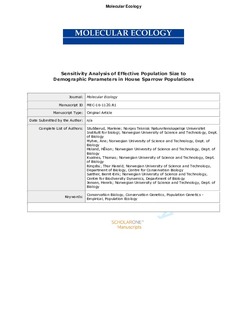| dc.contributor.author | Stubberud, Marlene Wæge | |
| dc.contributor.author | Myhre, Ane Marlene | |
| dc.contributor.author | Holand, Håkon | |
| dc.contributor.author | Kvalnes, Thomas | |
| dc.contributor.author | Ringsby, Thor Harald | |
| dc.contributor.author | Sæther, Bernt-Erik | |
| dc.contributor.author | Jensen, Henrik | |
| dc.date.accessioned | 2017-10-30T13:54:12Z | |
| dc.date.available | 2017-10-30T13:54:12Z | |
| dc.date.created | 2017-03-30T13:22:54Z | |
| dc.date.issued | 2017 | |
| dc.identifier.citation | Molecular Ecology. 2017, 26 (9), 2449-2465. | nb_NO |
| dc.identifier.issn | 0962-1083 | |
| dc.identifier.uri | http://hdl.handle.net/11250/2462928 | |
| dc.description.abstract | The ratio between the effective and the census population size, (math formula), is an important measure of the long-term viability and sustainability of a population. Understanding which demographic processes that affect (math formula) most will improve our understanding of how genetic drift and the probability of fixation of alleles is affected by demography. This knowledge may also be of vital importance in management of endangered populations and species. Here, we use data from 13 natural populations of house sparrow (Passer domesticus) in Norway to calculate the demographic parameters that determine (math formula). Using the global variance-based Sobol’ method for the sensitivity analyses, we found that (math formula) was most sensitive to demographic variance, especially among older individuals. Furthermore, the individual reproductive values (that determine the demographic variance) were most sensitive to variation in fecundity. Our results draw attention to the applicability of sensitivity analyses in population management and conservation. For population management aiming to reduce the loss of genetic variation, a sensitivity analysis may indicate the demographic parameters towards which resources should be focused. The result of such an analysis may depend on the life history and mating system of the population or species under consideration, because the vital rates and sex–age classes that (math formula) is most sensitive to may change accordingly. | nb_NO |
| dc.language.iso | eng | nb_NO |
| dc.publisher | Wiley | nb_NO |
| dc.relation.uri | http://onlinelibrary.wiley.com/doi/10.1111/mec.14057/full | |
| dc.title | Sensitivity analysis of effective population size to demographic parameters in house sparrow populations | nb_NO |
| dc.type | Journal article | nb_NO |
| dc.description.version | submittedVersion | nb_NO |
| dc.source.pagenumber | 2449-2465 | nb_NO |
| dc.source.volume | 26 | nb_NO |
| dc.source.journal | Molecular Ecology | nb_NO |
| dc.source.issue | 9 | nb_NO |
| dc.identifier.doi | 10.1111/mec.14057 | |
| dc.identifier.cristin | 1462382 | |
| dc.relation.project | Norges forskningsråd: 204303 | nb_NO |
| dc.relation.project | Norges forskningsråd: 221956 | nb_NO |
| dc.relation.project | Norges forskningsråd: 223257 | nb_NO |
| dc.description.localcode | This is the pre-peer reviewed version of the following article: [Sensitivity analysis of effective population size to demographic parameters in house sparrow populations], which has been published in final form at [http://onlinelibrary.wiley.com/doi/10.1111/mec.14057/abstract]. This article may be used for non-commercial purposes in accordance with Wiley Terms and Conditions for Self-Archiving. | nb_NO |
| cristin.unitcode | 194,66,10,0 | |
| cristin.unitname | Institutt for biologi | |
| cristin.ispublished | true | |
| cristin.fulltext | postprint | |
| cristin.qualitycode | 2 | |
